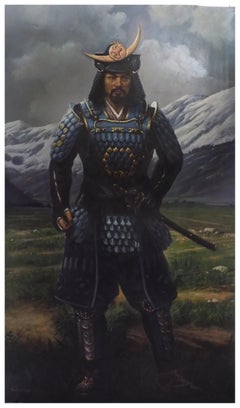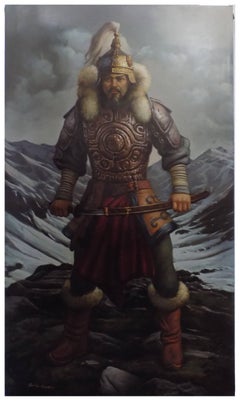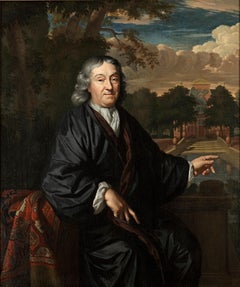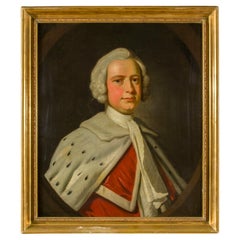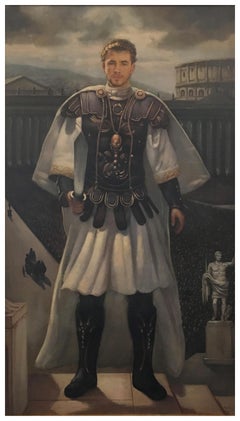Maximilian Ciccone Portrait Paintings
to
2
Overall Width
to
Overall Height
to
2
2
2
2
2
2
1
1
1
2
2
2
2
10
280
83
78
76
2
Artist: Maximilian Ciccone
SAMURAI -Italian School - Oil on Canvas Italian Figurative Painting
By Maximilian Ciccone
Located in Napoli, IT
Samurai - Maximilian Ciccone - Italia - Oil on canvas cm.210x120-
In this majestic oil on canvas painting the Artist Ciccone portrays a samurai, exhibiting the Japanese warrior cast...
Category
2010s Old Masters Maximilian Ciccone Portrait Paintings
Materials
Canvas, Oil
GENGHIS KHAN - Italian School - Oil on Canvas Italian Figurative Painting
By Maximilian Ciccone
Located in Napoli, IT
GENGIS KAN - Maximilian Ciccone - Italia - Oil on canvas cm.210x120.
In this majestic oil on canvas painting the Artist Ciccone portray the Mongol leader and ruler Genghis Khan...
Category
2010s Old Masters Maximilian Ciccone Portrait Paintings
Materials
Canvas, Oil
Related Items
Male and female portrait, both in silk kimono, possibly textile dealers
By Christoffel Lubieniecki
Located in Amsterdam, NL
CHRISTOFFEL LUBIENIECKI (1659-1729)
Pair of portraits of a gentleman and a lady, both in silk kimono, before a country house (circa 1680)
Indistinctly signed “C.......” on a box under the man’s left hand
Oil on canvas, 79.5 x 67 cm each
Both sitters are portrayed wearing a silk “Japanese” coat. During the second half of the seventeenth the Japanese silk coat, an adapted Japanese kimono, became a real vogue in the Dutch elite. The exclusive Dutch trade contacts with Japan can explain the popularity of the kimono-style silk coats in the Netherlands. Everybody who could afford one, dressed in such a fashionable and comfortable coat and, like the present sitters, some proud owners had themselves portrayed in a “Japanese” coat often together with an oriental carpet to underline their standing and international connections. These portraits are the work of the Polish-born portraitist Christoffel Lubieniecki (also known as Lubienitski, Lubinitski or Lubiniecki)
Lubieniecki was first trained in Hamburg under Julian Stuhr and after 1675 in Amsterdam under Adriaen Backer and Gerard de Lairesse. He specialized in landscapes, generally of an Italianate character, and in portraits. The loving execution of these contented burghers, enjoying the garden vistas of their country house, places him alongside Amsterdam portraitists such as Constantijn Netscher and Michiel van Musscher...
Category
1680s Old Masters Maximilian Ciccone Portrait Paintings
Materials
Canvas, Oil
$37,600
H 31.34 in W 26.38 in D 1.97 in
Thomas Hudson Style 18th Century English Portrait
By Thomas Hudson
Located in Roma, IT
Important English school painting in the style of the great artist Thomas Hudson (Devonshire 1701 - Twickenham 1779)
It depicts the portrait of Harry Gray (1715-1768), 4th Earl of St...
Category
1750s Old Masters Maximilian Ciccone Portrait Paintings
Materials
Canvas, Oil
18th Century by Alessandro Longhi Portrait of a young musician Oil on canvas
Located in Milano, Lombardia
Alessandro Longhi (Venice, Italy, 1733 – 1813)
Title: Portrait of a young musician in front of his desk with a score in his hand
Medium: Oil on canvas
Dimensions: without frame 39.5 ...
Category
18th Century Old Masters Maximilian Ciccone Portrait Paintings
Materials
Canvas, Oil
$13,583 Sale Price
20% Off
H 15.56 in W 12.8 in
19th Century by Sir Henry Raeburn Portrait of a landowner Oil on canvas
By Sir Henry Raeburn
Located in Milano, Lombardia
Sir Henry Raeburn (Stockbridge, Edinburgh, UK, 1756 - Edinburgh, UK, 1823)
Title: Portrait of a landowner
Year: Early 19th century, 1803
Medium: Oil on canvas
Dimensions: Without fra...
Category
Early 19th Century Old Masters Maximilian Ciccone Portrait Paintings
Materials
Oil, Canvas
$36,771 Sale Price
20% Off
H 63.78 in W 51.46 in D 1.58 in
18th Century by Pietro Bardellino Mary Magdalene Painting Oil on Canvas
By Pietro Bardellino
Located in Milano, Lombardia
Pietro Bardellino (Naples, Italy, 1731 – 1806)
Title: Mary Magdalene
Medium: Oil on canvas
Dimensions: without frame 75 x 60 cm – with frame 97 x 82 cm
Antique shaped and carved wood...
Category
Mid-18th Century Old Masters Maximilian Ciccone Portrait Paintings
Materials
Oil, Canvas
$15,698 Sale Price
22% Off
H 29.53 in W 23.63 in D 1.97 in
16th Century by Bernardino Detti Face of Christ Oil on Canvas
Located in Milano, Lombardia
Bernardino Detti (Pistoia, Italy, 1498 - 1572)
Title: Face of Christ
Medium: Oil on canvas
Dimensions: without frame 41 x 32 cm - with frame 47 x 55.5 cm
Antique box frame made of solid wood and walnut burl.
Publications: unpublished
The painting by Bernardino Detti (1498 - 1572) depicts the face of Jesus...
Category
16th Century Old Masters Maximilian Ciccone Portrait Paintings
Materials
Canvas, Oil
$18,800 Sale Price
20% Off
H 16.15 in W 12.6 in
17th Century by Andrea Vaccaro Penitent Magdalene Oil on canvas
Located in Milano, Lombardia
Andrea Vaccaro (Naples, Italy, 1604 – 1670)
Title: Penitent Magdalene
Year: 1630-1635 ca.
Medium: Oil on canvas
Dimensions: without frame 75 x 62 cm – with frame 87.5 x 74.7 x 5.5 cm...
Category
17th Century Old Masters Maximilian Ciccone Portrait Paintings
Materials
Canvas, Oil
$55,366 Sale Price
20% Off
H 29.53 in W 24.41 in
17th Century by Giuseppe Assereto Portrait of an Elderly Woman Oil on Canvas
By Giuseppe Assereto
Located in Milano, Lombardia
Giuseppe Assereto (Genova - 1626 ca – Genova 1656/57)
Title: Portrait of an elderly woman, possible portrait of Maddalena Massone, wife of Gioacchino Assereto
Medium: Oil on canvas
D...
Category
Early 17th Century Old Masters Maximilian Ciccone Portrait Paintings
Materials
Oil, Canvas
$36,566 Sale Price
21% Off
H 25.79 in W 20.28 in D 1.97 in
Oil on Canvas Painting Portrait of the Italian Noble Family of Zanardi Count
By Lucia Casalini Torelli
Located in Firenze, IT
This museum quality old master oil on canvas formal portrait painting depicting the family of the Count Zanardi is signed by the artist- the female painter Lucia Casalini Torelli- and published in a book dedicated to Casalini Torelli’s workshop and academy.
This palatial masterpiece artwork comes directly from the ancient Villa Maraini Guerrieri - Palidano di Gonzaga (Mantua), an historic Italian heritage building owned by the descendants of the family portrayed for more than two centuries, until 1998.
The big scale of this oil on canvas masterpiece painting states the relevance of Lucia Casalini Torelli as a painter. The present artwork is a formal family portrait painting that aim to introduce the characters depicted according to their social role in the society. The noble family is all gathered under a loggia overlooking a park, the landscape in the background is partially covered by a beautiful red cloth on the right side.
The father stands up and holds the hand of his eldest son, proudly introducing his future heir. The son wears a light-blue dress and red boots, he is depicted in a serious pose holding a black tricorn hat under his arm and a rapier sword on his belt.
The mother wears an elegant gold and dark green brocade dress, she is sitting with her youngest daughter on her knees while her second son is by her side. The little daughter wears a lovely long red and dress with white lace and holds an apple on her hand. The son stands next to his mother and is dressed in a brown priestly clothes.
This palatial old masters piece was probably painted in 1740 due to the similarities with Cardinal Doria’ s portrait, now on display at the Doria Palace Museum, the official residence of the Prince of Genoa.
The painting features original canvas (“prima tela”) and antique original patina, it is in excellent overall condition considering the age, use and its large scale. A formal detailed condition report and the results of the inspection with the UV lamp accompanied by photos is available on request.
As well as for its exceptional quality and quite perfect state of conservation, this painting is particularly important and even more valuable both for the artist who painted it and for its absolutely exclusive provenance.
Lucia painted the most prominent and powerful noble families of her time, the location of these paintings is unknown to the art market as it is extremely likely that the portraits are still kept in private collections.
Furthermore, Lucia was one of the most appreciated artists of her time, so important that she was admitted as a member of the academy at a time when women were forbidden to attend these studies.
In 1706, Felice Torelli...
Category
18th Century Old Masters Maximilian Ciccone Portrait Paintings
Materials
Canvas, Oil
$170,375
H 94.49 in W 85.44 in D 1.19 in
17th Century Antiveduto Gramatica Magdalene Praying with a Skull Oil on Canvas
Located in Milano, Lombardia
Antiveduto Gramatica or Grammatica (Rome, Italy, 1571 – 1626)
Title: Magdalene Praying with a Skull
Medium:Oil on canvas
Dimensions: without frame 58 x 43.2 cm - with frame 85 x 72 x...
Category
17th Century Old Masters Maximilian Ciccone Portrait Paintings
Materials
Canvas, Oil
$78,302 Sale Price
20% Off
H 22.84 in W 17.01 in D 2.37 in
18th c. French Portrait of a Lady as Venus, attributed to Pierre Gobert
By Pierre Gobert
Located in PARIS, FR
Portrait of a Lady as Venus
ATTRIBUTED TO PIERRE GOBERT (1662-1744)
FRENCH SCHOOL AROUND 1720
OIL ON CANVAS: H. 55.51 in, W. 42.91 in.
IMPORTANT 18TH CENTURY GILTWOOD FRAME (RE-GILT)...
Category
Early 18th Century Old Masters Maximilian Ciccone Portrait Paintings
Materials
Canvas, Oil
$32,139 Sale Price
20% Off
H 68.9 in W 55.91 in
Antique oil paining, A laughing man with an upturned glass, Dutch golden age
Located in DEVENTER, NL
Anonymous, 18th century
Inspired by a painting by Petrus Staverenus (1610/1612 – 1654-07-28/1664-07-28) from a series of Five Senses
'Taste: A laughing man...
Category
18th Century Old Masters Maximilian Ciccone Portrait Paintings
Materials
Canvas, Oil
$1,938
H 29.34 in W 23.63 in
Previously Available Items
COMMODO - Italian School - Italia - Figurative - Oil on canvas painting
By Maximilian Ciccone
Located in Napoli, IT
Commodo - Maximilian Ciccone - Italia - Oil on canvas, portrait of Roman Emperor Commodo.Mis. cm. 210x120-
Category
Early 2000s Old Masters Maximilian Ciccone Portrait Paintings
Materials
Canvas, Oil
Maximilian Ciccone portrait paintings for sale on 1stDibs.
Find a wide variety of authentic Maximilian Ciccone portrait paintings available for sale on 1stDibs. You can also browse by medium to find art by Maximilian Ciccone in canvas, fabric, oil paint and more. Much of the original work by this artist or collective was created during the 21st century and contemporary and is mostly associated with the Old Masters style. Not every interior allows for large Maximilian Ciccone portrait paintings, so small editions measuring 48 inches across are available. Customers who are interested in this artist might also find the work of Sir Godfrey Kneller, and Studio of Sir Peter Lely. Maximilian Ciccone portrait paintings prices can differ depending upon medium, time period and other attributes. On 1stDibs, the price for these items starts at $3,843 and tops out at $3,843, while the average work can sell for $3,843.
